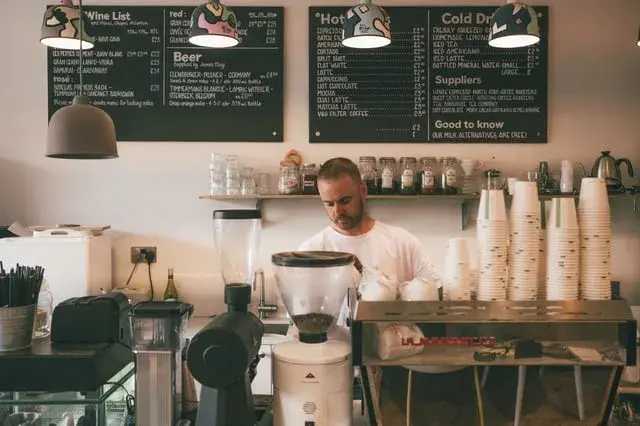Alex Rinna always says she was born into Popeye’s. She grew up knowing fast food, because her dad worked on both the corporate and franchise side of the chicken chain. She’s now a franchisee of 16 locations in the Southeast with Rinna Restaurant Group, but she wasn’t born into that kind of leadership—she learned it by working at Popeye’s from the ground up, and has expanded it by keeping her focus local.
“When I first joined the company, my goal was for people to look at us as a local restaurant and not a big brand restaurant,” Alex says. “I think it's very hard to distinguish between the two.”
Besides opening several new Popeye’s locations, Alex is also on the company’s International Franchise Association Marketing Committee, where she helps build successful marketing calendars to create new competitive assets. Yet some of her biggest advice to franchisees is to lean into the local community rather than relying solely on corporate strategies.
For all that most QSR corporations do to support and structure franchises, they don’t typically tell you how to get involved in your local community. Doing so is the franchisee’s own choice. “It’s a very smart business choice,” Alex says. “But it’s the franchisee doing it themselves, so it’s very authentic. It’s not because we have a checklist. It’s because we truly just want to give back, show our appreciation and gain new customers. We want to be a great part of the community.”
In fact, Alex calls those three bolded terms her pillars for building a franchise strategy as a local business sporting a global brand. In this interview, she highlights those three interconnected approaches and digs into how franchisees can budget wisely and maximize their impact—whether they’re an established presence or just getting started.
The three pillars for local franchisees
Giving back: “My parents have always taught me to give back,” Alex says. “We’re blessed to even have the option to provide food for organizations, charities and businesses if they’re in need.”
Just the act of sharing meals can make a significant impact on a community—and Alex sees that it builds lasting relationships, too. “They’ll always come back,” she says. “And it’s not like they ever take advantage of us. I see these people in our stores constantly.”
Showing appreciation: Alex points out that a lot of businesses miss out on opportunities to show appreciation to the community. Feeding teachers on Teacher Appreciation Week? Offering food to local law enforcement? Giving free meal coupons to kids who make good grades? These bits here and there will put a smile on someone’s face and show them that you truly care.
Reaching new customers: At the end of the day, your business is just that—a business. So Alex recognizes that the best way to remain an active member of the community is to keep bringing in new customers. And there are always new customers, even when you fly a big-name flag.
“The amount of people who have still never tried Popeye’s is insane,” she says. “When you add in third-party delivery apps, you reach a whole new audience. When we added in the famous chicken sandwich, we reached a whole group that had never tried bone-in chicken. And then, local store marketing reaches out to your local audience who has never walked in.”
Of course, the ways Alex recommends for reaching new local customers are largely the first two pillars: giving back and showing appreciation inevitably reach new customers. When she provides a local football team a free pregame meal, for instance, the odds are that not all 200 players have eaten at her restaurant before.
“I get to provide them a meal, show them that Popeye’s is rooting for them and hopefully gain some loyal customers in the end,” she says.
Maximize your effect
We all work under the constraints of budgets and time, and it’s impossible to take hold of every single opportunity to give back, show appreciation and reach new customers. You have to pick and choose from those pillars based on what is most beneficial for your business.
Which is hard! Alex admits she has a hard time saying no when someone calls to ask about a donation of food. She has a much easier time saying no to advertising—because she feels that her pillars are a much more satisfactory (and effective) means of building her business in the community.
“With ads, there’s no guarantee that someone will even see it—or that it will bring them into Popeye’s,” Alex says. “I would rather create an experience, give someone a warm, fresh meal. And maybe they’ll become a new fan.”
So work smart, Alex says—and spin your marketing gears in ways that you can save money while maximizing your impact.
- Personalize the bang for your buck. Let’s say you have $1,000 to spend. You could become a gold sponsor for the high school basketball team and get a shiny banner in the auditorium. Or—you could show appreciation by feeding the team, the coaches and their families a pregame meal (or several) for the same cost. “In return, they’ll still shout you out as a sponsor,” Alex says. “I’ve gotten free ads in football programs. I’ve gotten free banners, our name on T-shirts. Just giving them a thousand dollars, versus giving them a whole meal—which gets you more in return?”
- Pick up recurring opportunities. A one-time donation is a great gesture of goodwill. But becoming a regular supporter keeps you giving back—as well as easing the stress and workload by standardizing your efforts. “Year after year, it’s not a lot of work because you know this month, you’re working with the school, and every summer you’re helping out the church camp,” Alex says. “You can really space it out, and it gets pretty easy once you get the ball rolling.”
- Focus on the return rather than the cost. When Alex first started as a director of marketing, she had a clear marketing budget. So one strategy she leaned into was gifting coupons for free kids meals to local elementary schools, which they passed on to students who made the honor roll. It cost her nothing more upfront than the cost of printing coupons—with a baked-in return on each freebie redeemed. “Yeah, you’re giving away a free kids meal,” she says, “but the odds of the kids coming to redeem that coupon and not having their entire family with them is very slim. You just gained a bunch of orders—and hopefully more loyal customers.”
“You just have to be smart in where you’re spending the money,” Alex reiterates. “Create ways that get you benefits without wasting all your marketing dollars.”
Get started—wherever you stand
One of the beauties of Alex’s think-local strategy is that any franchisee can implement it, at any time, whether they’re looking to open their first restaurant or they already run a hundred.
The core of her approach is to get food in the hands (and mouths) of the community. The beauty of it is, who’s going to turn down free food?
“I never get told no,” Alex says. “If I reach out to an organization and ask if there’s any way we can help them out by donating food, they never turn around and say they don’t want our help. It’s not like a sales call, when you’re scared they’re going to say no. It’s a pretty easy path to gain those relationships and keep building them.”
Free meals are indeed an easy sale—but here are some of Alex’s other bites of wisdom for getting things going:
- Begin within your means. You may not have the budget to embrace all three of Alex’s pillars fully. But you can pick and choose opportunities within each one. If feeding the football team or the marching band is too ambitious, what about the smaller basketball and volleyball teams instead? Or, offering them just sandwiches instead of full meals? Giving back and showing appreciation don’t have to happen on grand scales to be meaningful to the recipients. “I promise you, people are so appreciative of any donation, small or large,” Alex says. “We have given just biscuits before and it’s the best thing ever.”
- Be proactive in making your connections. Rather than waiting for organizations to ask you for donations and support, seek them out. You can imagine how much more meaningful an unsolicited donation is. It also shows consideration if you contact an organization to coordinate your offer when it works well for them—organizing a team lunch, for instance, rather than simply showing up one day with food.
- Start before you start—by which we mean, begin your efforts even before you open the doors. Alex goes full force on a grand opening. In the two months before opening, she reaches out to local newspapers, radio stations, law enforcement organizations, chambers of commerce, school principals, and invites them all to the friends-and-family soft opening. “The relationships just grow and grow,” she says. “And you never have to back peddle after you’ve been open for a year. We do it right off the bat to show we’re so excited to be in this area and join this community.”
Final thoughts: Bridge the gap to the community
The crux of Alex’s local outreach strategy is that she is not actively trying to sell her restaurants to the community. Her connections are genuine, her support heartfelt. Participating in the community is not simply a marketing strategy: it’s a goal in and of itself.
“Number one is bridging that gap between the restaurants and the community,” she says.
She points out that franchisees like her are not alone in this effort. Her general managers usually come from the areas that the locations are in. They have at least as many contacts as she does, and they tend to feel passionate about supporting their communities.
“Our managers have relatives that work at the fire station, or their nieces and nephews and kids are on Little League teams,” she says. “We’re there to step in, help them out, and it means a lot to them, and to our business, and to our community.”
Which is another way to say: bridging gaps starts with saying hi and offering your help. Anyone can do it. Simple as that.
“It’s a lot of work, but if someone is out there who has never really dipped their toe in the local store marketing pool, they definitely can,” Alex says. “It’s very doable, and it’s never too late to start getting out there.”





